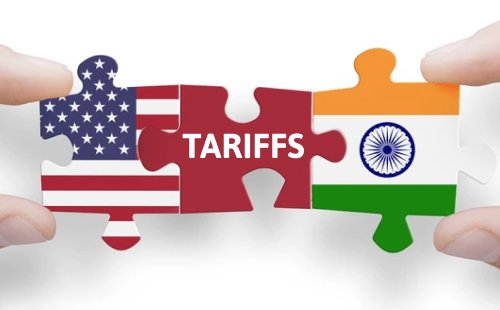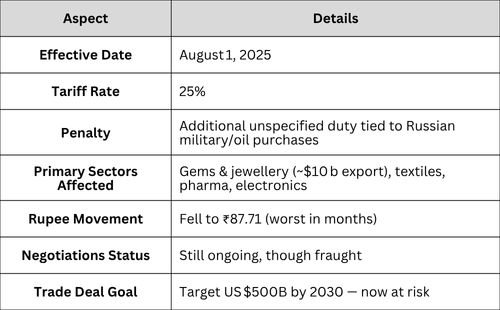
In the United States, President Donald Trump declared on July 30, 2025, that a 25% tariff on Indian imports would go into effect on August 1. The move targets Indian exports including textiles, gems & jewellery, pharmaceuticals, and electronics. (Reuters,Moneycontrol)
Also announced alongside this tariff was an unspecified penalty, aimed at India’s continued oil and military procurement from Russia, viewed as funding Russia’s war in Ukraine. (AP News).
Why the Tariff? Trade Frictions and Geopolitics
Trump pointed to India’s high average tariffs, including farm tariffs averaging 39%, and strict non‑tariff barriers as justification. He contended that U.S. exporters face unfair trade hurdles, while India purchases significant quantities of Russian energy and defence gear (Reuters).
He also criticised India’s membership in BRICS, calling it part of a bloc attempting to undermine the U.S. dollar. (Moneycontrol).
Export Downturn: Impact on Key Sectors
Gems & Jewellery
India’s gems & jewellery industry, a major export sector contributing about US $10 billion annually to U.S. trade, is expected to suffer sharp declines. The U.S. accounts for 30% of India's gems exports, making this a significant blow to the country’s largest diamond processing hub (Moneycontrol).
Textiles, Leather, Pharma & Electronics
These traditional export segments are likely to become uncompetitive under the new tariff regime. Analysts warn that Indian goods may lose ground to competitors like Vietnam and Bangladesh in the United States market.
Market and Economic Response in India
In financial markets, the Indian rupee slid 28 paise to open at ₹87.71 to the dollar on July 31, marking its lowest level in five months. The depreciation reflects growing investor concern over rising trade tensions with the U.S. (Moneycontrol).
Yet some market experts, like Shankar Sharma, suggest the sectoral composition of Indian exports means the tariff may not trigger long‑term economic disruption, though it could weigh on sentiment in a slow earnings season (Moneycontrol).
Diplomacy and Trade Talks at a Standstill
Despite the tariff announcement, Trump stressed that negotiations with India are ongoing, implying potential revisions before the end of the week. Meanwhile, Indian officials maintain that New Delhi remains committed to a fair, balanced, mutually beneficial trade deal (Reuters).
Trade talks had earlier aimed to deliver a phase‑one agreement by autumn 2025, with ambitions to grow bilateral trade to US $500 billion by 2030. The tariff threat has put those goals in jeopardy (Reuters).
Outlook: Risks, Reactions, Opportunities
- Global trade negotiations heat up: Trump has already negotiated revised deals with South Korea, the EU, UK and others—India now faces heightened scrutiny (The Washington Post,The Economic Times).
- Possible outcomes: In reaction to recently increased tariff duties, Indian exporters might look for new market options or redirect supply chains.
- Tension between policy and diplomacy: The dual message of tariffs and geopolitical penalties may undermine bilateral collaboration and encourage India to expand its trading alliances.
Summary Table

Key Takeaway
The decision from the Trump administration to impose a 25% tariff on Indian goods, coupled with a penalty related to India‑Russia ties, points to growing tensions in U.S.–India trade relations. With negotiations continuing under tight deadlines and major export sectors in jeopardy, India now faces a pivotal moment in navigating trade strategy amid macroeconomic uncertainty and geopolitical recalibration.
Get Accurate Diamond Prices with Our Smart Calculator App
Looking for real-time price estimates that match Rapaport standards?
Effortlessly check and calculate diamond values on the go—trusted by over 1,000 professionals globally.